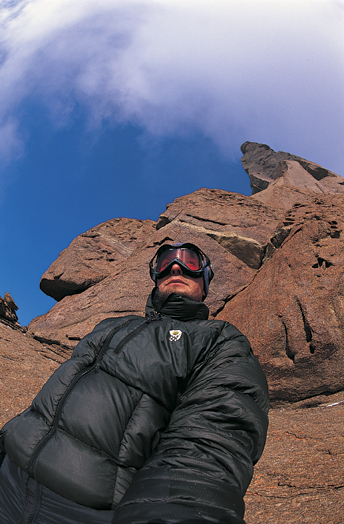Dronning Maud Land, First Ascents. I flew from Cape Town to the Russian
Base of Novolazarevskaya, in Dronning Maud Land, landing on the ice
tarmac on Halloween. Before my sixth step onto the frozen continent, my
face was numb and my nostril hair had frozen. I had hoped the early
season would be warmer than this.

Mike Libecki on the first ascent of Frozen Tears (5.10 A3, 460m), Windmill Spire (ca.2300m), Dronning Maud Land (aka Queen Maud Land), Antarctiva. In November and December, 2005, Libecki spent five weeks solo in Donning Maud Land, where he managed two new routes, one of which nearly killed him. [Photo] Raphael Slawinski
After a two-hour flight from Novolazarevskaya, small islands of pure
granite walls and towers emerged from the ice. I signaled where I wanted
to land; the pilots seemed confused that I would attempt to climb these
strange formations by myself. In a way, I felt the same.
There were two things that concerned me about spending the next five
weeks climbing alone in Antarctica: the katabatic winds and the hideous,
rotten granite. After a day of kite skiing and scoping routes, I found
several aesthetic lines to summits. I could tell most of them would
involve kitty-litter rock; however, one in particular, on a beautiful
ship’s prow, looked promising. Before long, despite the high winds and
negative temperatures, I had three pitches fixed. As I traversed a small
ledge beneath a hollow spiderweb of cracks, two haulbag-sized flakes
stood in my way. On a good stance with bomber gear, I touched one of the
flakes and they both went crashing toward the ground. A chain reaction
started immediately as large pool-table-shaped flakes, part of a
splitter crack system in a dihedral corner about ten feet to the right
of me, exploded. A truck-sized mass of granite let loose, followed by
more thunder and falling stone. I closed my eyes and tucked into the
fetal position. The wall shook; it sounded as if it were crumbling. All
of the stone to my right, including part of my intended route, erupted.
The explosions rattled loose stones from above. When it was over, what
seemed like seconds and yet hours later, I gasped for breath. There was
silence, a small chilly breeze, bright blue sky and a gleaming sun. I
felt hot and wet. Then I realized I had peed my pants.
I rappelled the route shivering from fear and shock. When I awoke
fifteen hours later, I felt a new energy about me. I was still in
Antarctica. I had ventured every bit of my energy and know-how to get
here. I took the day to digest the experience and consider my options.
Nearby, a route on a beautiful spire led to a small
cafe-table-sized summit. In and out of wind battles and storms, I
found mostly solid stone and made the summit sixteen days later.
Standing on top was glorious, but the fear of rotten rock had consumed
most of the enjoyment of getting there. I had tiptoed with each move and
even wore free-climbing shoes the entire time for precision, despite the
obvious frostbite I would have to endure. I barely slept each night.
Nonetheless, my route Frozen Tears (5.10 A3, ca. 460m) had taken me to
the summit of the needle-like Windmill Spire (ca. 2300m).
Safely back at camp, I enjoyed the sunset rolling across the horizon.
Though I would be leaving soon, I still wanted to stand on top of the
ship’s prow. Three days before the Russians picked me up, I skied to the
back of the ship’s prow and went for a push on its long, dragon-back
ridge. Several hours later I found myself atop the summit, having
climbed one of the most beautiful ridgelines I have ever seen: the
Dragon Back Ridge (5.5, 760m).
Mike Libecki, Salt Lake City, Utah